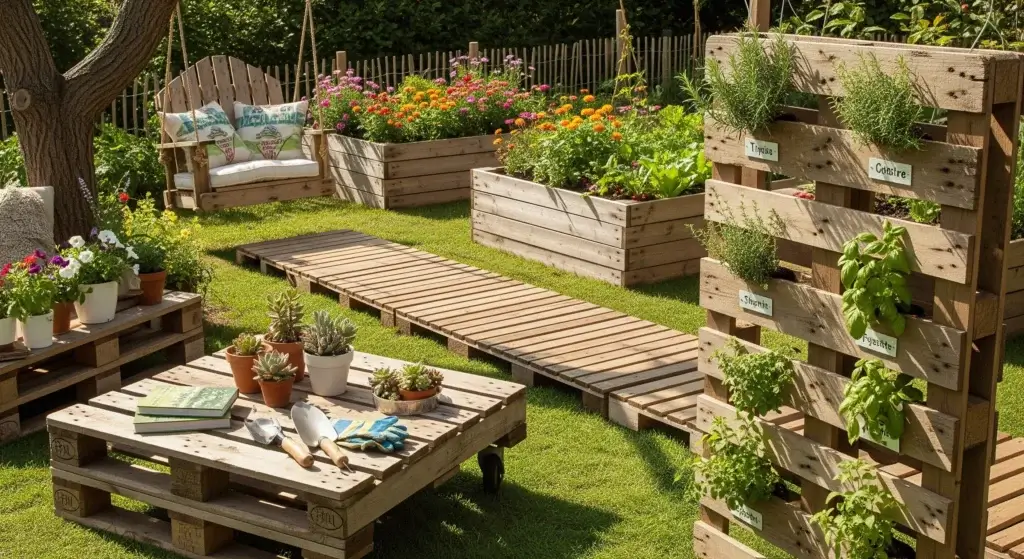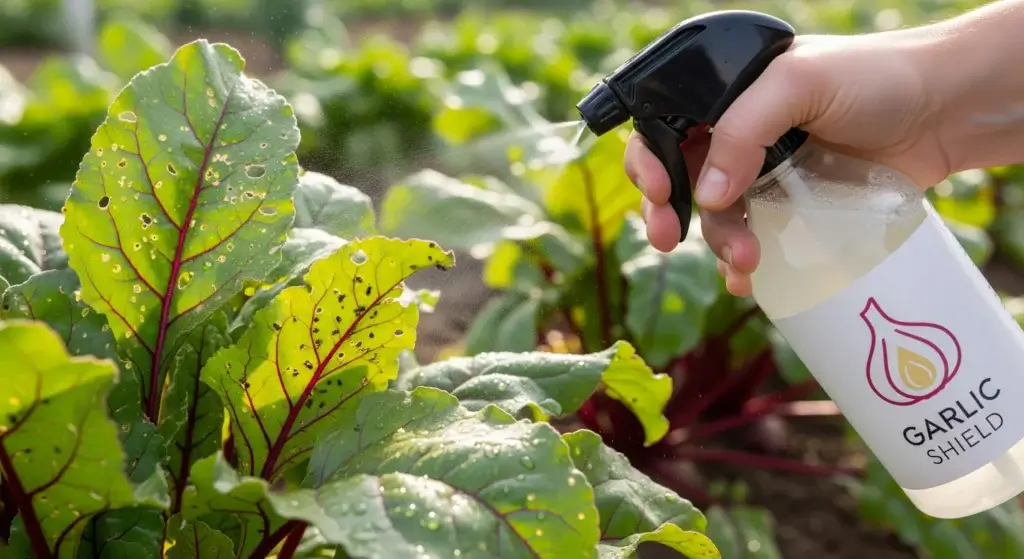
Asparagus is a delightful and nutritious addition to any home garden.
Not only does it offer a delectable taste, but it’s also a perennial vegetable, meaning that once you’ve planted it, you can enjoy its bounty for up to 20 years.
In this comprehensive guide, we’ll walk you through the process of planning, building, and nurturing your very own DIY asparagus bed.
We’ll cover everything from choosing the right spot and when to plant, to bed size and design, and the step-by-step process of building your bed.
Additionally, we’ll provide tips on nurturing your asparagus, harvesting, and even companion planting to enhance growth and deter pests.
Planning Your Asparagus Bed
Choosing the right spot
Asparagus is a sun-loving plant, so selecting a well-drained, sunny location is crucial.
Ensure the chosen area in your garden receives ample sunlight and has effective drainage to promote optimal growth.
Well-drained soil prevents waterlogging, fostering a healthy environment for your asparagus.
- Read also: 8 DIY Garden Fence Ideas for a Perfect Oasis
- Read also: DIY Garden Decor Ideas for a Stunning Outdoor Oasis
When to plant
Timing is key when planting asparagus.
The optimal planting time is in early spring when the soil becomes workable.
This allows your asparagus to establish its roots before the growing season, providing a head start for robust and vigorous growth.
Be attuned to the soil’s workability to ensure the best conditions for planting.
Bed size and design
Asparagus is a long-term crop, boasting a potential lifespan of around 20 years.
With this longevity in mind, it’s essential to carefully plan the size and design of your asparagus bed.
Dedicate a permanent space, considering several square meters based on the number of plants you intend to grow.
Proper bed preparation is key to supporting the sustained health and productivity of your asparagus plants.
Varieties and sources
Explore the diverse world of asparagus varieties, each offering unique characteristics.
Popular choices include ‘Mondeo’, ‘Guelph Millennium’, ‘Gijnlim’, and ‘Vittorio’.
Research these varieties to understand their specific traits, such as flavor profiles and growth habits.
Obtain your selected asparagus varieties from reputable nurseries or garden centers to ensure quality and authenticity.
Soil preparation
Prepare the soil meticulously before planting your asparagus bed.
Asparagus thrives in well-drained, nutrient-rich soil.
Incorporate organic matter, such as compost or well-rotted manure, to enhance soil fertility.
Conduct a soil test to assess pH levels, aiming for a slightly acidic to neutral range (6.0-7.0) for optimal growth.
Planting technique
When planting asparagus, dig trenches that are about 6-8 inches deep.
Space the trenches about 18 inches apart to accommodate the asparagus crowns.
Place the crowns at the bottom of the trenches, covering them with a few inches of soil initially.
Gradually fill in the trenches as the asparagus shoots emerge, allowing them to grow and establishing a healthy root system.

Building Your Bed: Step-by-Step
Gather your tools
Before embarking on your asparagus bed project, ensure you have all the necessary tools readily available.
Items such as a wheelbarrow, shovel, rake, compost, organic fertilizer, weed fabric (optional), and edging material (optional) are essential for a smooth and efficient process.
Preparing the site
Kickstart your asparagus bed construction by preparing the chosen site.
Clear the area of existing vegetation, remove debris, and till the soil to create a favorable environment for your asparagus to flourish.
This initial step sets the stage for optimal plant growth and productivity.
Building the foundation
Choose between two primary methods for building the foundation of your asparagus bed: the traditional trench method or the no-dig method, which is simpler and less disruptive.
The trench method involves digging furrows for planting, while the no-dig approach utilizes layers of organic materials to create a nutrient-rich bed.
Adding nutrients
Infuse your soil with vital nutrients by incorporating compost and organic fertilizer.
These additions provide the necessary elements for robust asparagus growth.
Follow specific guidelines for your soil type, ensuring an optimal balance that fosters a nutrient-rich environment for your plants.
Creating the rows
Carefully plan and create rows for planting, considering the mature size of asparagus plants.
Ensure adequate spacing between rows to facilitate accessibility and proper plant development.
This thoughtful arrangement contributes to an organized and visually appealing asparagus bed.
Planting the crowns
Position the asparagus crowns in the prepared soil according to your chosen method—either within the trenches or atop the layered organic material.
Cover the crowns with soil and water them deeply.
Adequate watering at this stage promotes healthy growth and establishes a robust root system for your asparagus plants.
Optional steps
Consider incorporating optional steps such as laying weed fabric to minimize weed growth or adding edging material for a defined and polished appearance.
These optional enhancements contribute to the overall maintenance and aesthetics of your asparagus bed.
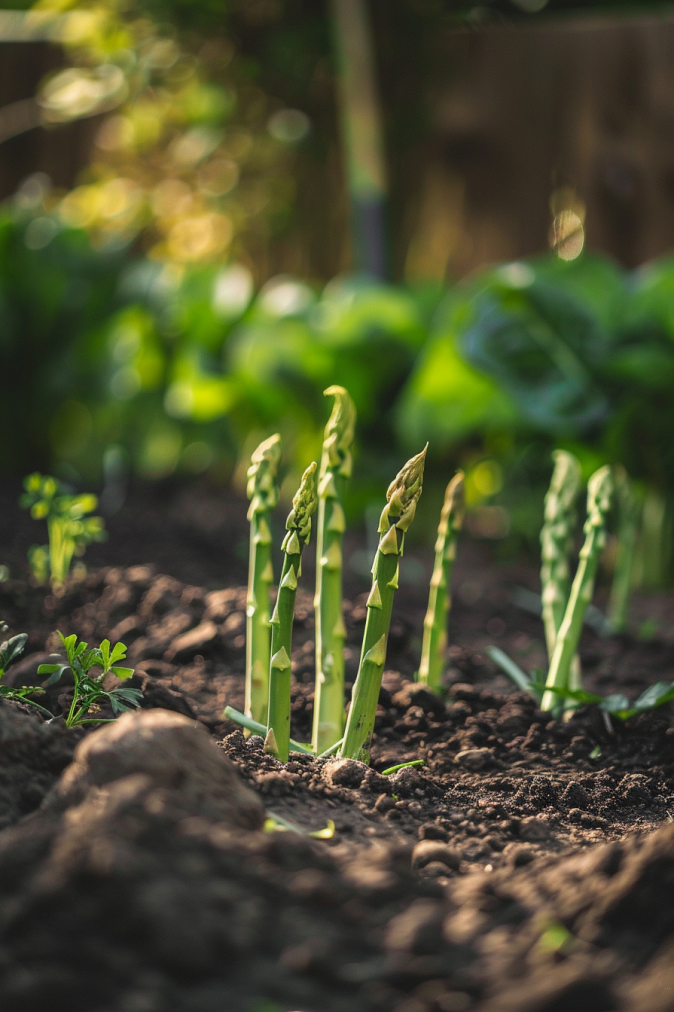
Nurturing Your Asparagus Dreams
Mulching
Mulching plays a crucial role in nurturing your asparagus bed.
In late winter, apply a layer of mulch to the bed to discourage weed growth and retain moisture in the soil.
Consider using a weed-suppressing membrane from autumn to winter to prevent the establishment of annual weeds.
Watering
While asparagus plants are generally drought-tolerant, strategic watering is essential, especially during extended dry spells.
During the first year, regular watering is crucial to help the plants establish a robust root system.
Monitor soil moisture levels and provide supplemental watering when needed.
Weed control
Maintaining a weed-free environment is paramount for the successful growth of asparagus. Hand weeding early in the season helps prevent weed competition, allowing your asparagus to thrive. Consider using weed fabric as a barrier to further control weed growth.
Patience is key
Cultivating asparagus demands patience, as the plants typically take 2-3 years to mature for harvest.
During this period, focus on diligent care and maintenance to ensure the long-term health and productivity of your asparagus bed.
Additional tips
- Monitor for pests: Keep an eye out for common pests such as asparagus beetles and aphids.
- Fertilize appropriately: Asparagus benefits from balanced fertilization. Apply a balanced fertilizer in spring as new shoots emerge to support vigorous growth.
- Pruning: Allow ferns to grow throughout the growing season, as they contribute to the development of strong crowns.
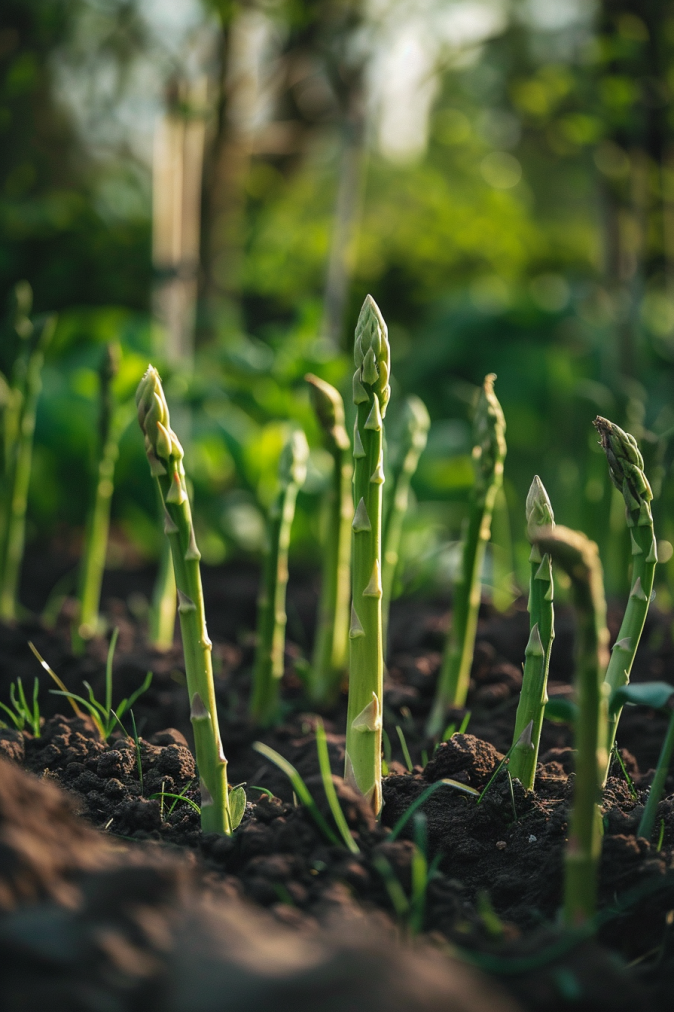
Harvest Time and Beyond
Signs of readiness
Identifying the right time for harvesting your asparagus is crucial for optimal flavor and tenderness.
Look for thick spears emerging in spring, a clear indicator that your asparagus is ready for harvest.
Sustainable harvesting
Adopt a sustainable approach when harvesting asparagus to promote the health of the plant and ensure future bountiful harvests.
When harvesting, leave some spears untouched, allowing them to mature and contribute to the overall vitality of the plant.
Enjoying the reward
Once harvested, savor the reward of your efforts by incorporating fresh asparagus into a variety of delicious recipes.
From savory tarts to grilled delights, the versatility of asparagus makes it a culinary delight.
Companion planting
Elevate the growth of your asparagus while deterring pests through companion planting.
Select plants that complement the growth of asparagus and contribute to a harmonious garden ecosystem.
Additional tips
- Crop rotation: To prevent soil-borne diseases and maintain soil fertility, practice crop rotation by relocating your asparagus bed every 10-12 years.
- Post-harvest care: After the harvest season, provide post-harvest care by applying a balanced fertilizer to replenish nutrients and support the development of strong crowns for the next season.
What Are The Benefits of Growing Asparagus at Home
Growing asparagus at home offers numerous benefits, making it a rewarding addition to your garden.
Asparagus is a nutrient-rich vegetable, providing essential vitamins such as E, C, A, and K, making it a valuable and healthy addition to your diet.
Additionally, asparagus is a low-maintenance crop, making it an easy and convenient vegetable to grow in your garden.
It is also a long-term investment, as asparagus plants can yield a bountiful harvest for up to 20 years, providing a sustainable source of fresh, homegrown produce.
Asparagus is also a versatile vegetable, offering a range of cooking options and a delicious taste, making it a delightful addition to your homegrown bounty.
Furthermore, asparagus is a powerful diuretic and a rich source of folic acid, which helps the body produce healthy cells, and vitamins A, C, K, and B6, making it a valuable and nutritious vegetable to include in your diet.
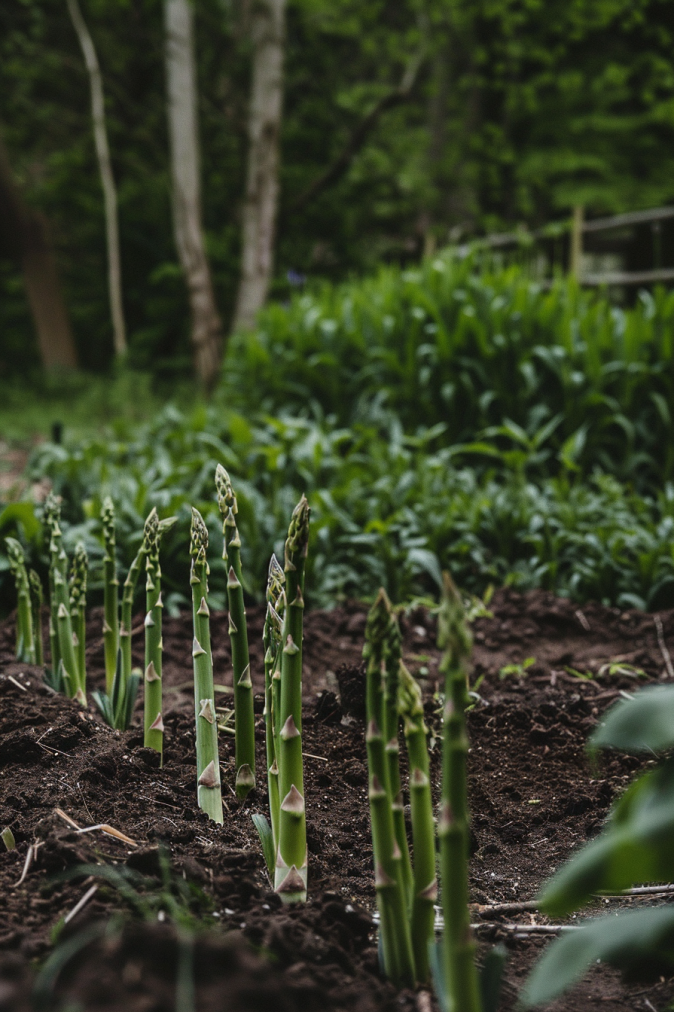
- Read also: Crafting DIY Plant Hangers with Rope
- Read also: A Guide to DIY Plant Wall Shelf Ideas
Conclusion
Embarking on the journey of growing your own asparagus is a rewarding and enjoyable endeavor.
With careful planning, dedicated bed construction, and diligent care, you can anticipate numerous years of relishing delicious, homegrown asparagus.
So, let’s roll up our sleeves, gather the essential tools, and prepare to savor the fruits (or, in this case, spears) of your labor!
Get ready for a fulfilling experience as you nurture and cultivate your own bountiful asparagus bed.
FAQs
The best time to plant asparagus is in early spring when the soil is workable. This will give your asparagus a head start in establishing its roots before the growing season.
Asparagus takes 2-3 years to mature for harvest. While the wait may seem long, the reward is well worth it!
Some popular varieties of asparagus include ‘Mondeo’, ‘Guelph Millennium’, ‘Gijnlim’, and ‘Vittorio’. These varieties offer unique characteristics and are well-suited for home gardens.


